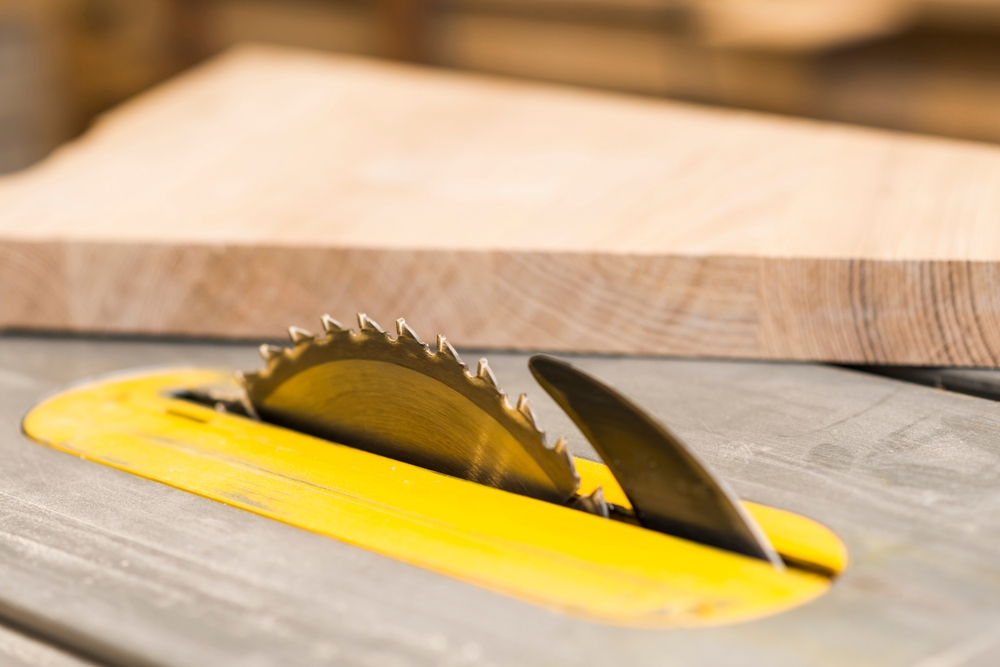A table saw is a versatile and essential tool for any woodworking or carpentry project. It allows you to make precise cuts with a variety of blades and accessories, and can handle a wide range of materials from soft woods to hard plastics. There are several different types of table saws available, including cabinet saws, contractor saws, and portable saws.
Cabinet saws are the most expensive and heavy-duty option, with a fully enclosed cabinet and a powerful motor for cutting thick materials. Contractor saws are a more affordable and portable option, with a lighter weight and an open base. Portable saws are the smallest and most portable option, with a lightweight design and a carry handle for easy transportation.
We will cover the basics of using a table saw, including setting up the saw, making basic cuts, and safety considerations. We will also discuss advanced techniques and maintenance tips to help you get the most out of your table saw.
Contents
Setting up the table saw
Before you can start using your table saw, you will need to unpack and assemble it according to the manufacturer’s instructions. This may include attaching the legs and wheels, attaching the motor and blade, and installing any other accessories that came with the saw.
- Unpacking and assembling the saw
- Installing the blade and setting blade height and bevel angle
- Adjusting the fence and miter gauge
Next, you will need to install the blade and set the blade height and bevel angle. To install the blade, first make sure the saw is unplugged and the blade guard is in place. Loosen the blade mounting bolts and remove the old blade, then place the new blade on the arbor and tighten the bolts securely.
The blade height is adjusted by raising or lowering the blade using the blade adjustment knob or lever. The bevel angle is adjusted by tilting the blade using the bevel adjustment knob or lever.
Once the blade is installed and adjusted, you can then set the fence and miter gauge. The fence is used to guide the material being cut and should be parallel to the blade. The miter gauge is used to make angled cuts and should also be adjusted to be parallel to the blade.
Basic table saw techniques
Once your table saw is set up and ready to go, you can start making basic cuts. Some of the most common cuts made with a table saw include straight cuts with the fence, angled cuts with the miter gauge, and crosscut sled cuts.
- Making straight cuts with the fence
- Making angled cuts with the miter gauge
- Using a crosscut sled for precise cuts
- Dado cuts and groove cuts
- Ripping long boards with the fence
To make a straight cut with the fence, align the material with the blade and the fence, and use the rip fence handle to hold the material securely against the fence. Slowly push the material through the blade, keeping your hands and fingers a safe distance away from the blade.
To make an angled cut with the miter gauge, set the miter gauge to the desired angle and align the material with the blade and the miter gauge. Hold the material securely against the gauge and push it through the blade.
A crosscut sled is a useful accessory for making precise cuts, especially when working with small or delicate materials. It consists of a sled with a fence and a stop block that slides along a rail on the table. To use the sled, align the material with the blade and the sled fence, and use the stop block to mark the cutting line.
Slowly push the sled through the blade, keeping your hands and fingers a safe distance away from the blade.
Other types of cuts that can be made with a table saw include dado cuts and groove cuts, which are used for creating joints in woodworking projects. Dado cuts are made with a dado blade, which is a special blade with multiple teeth that can cut a wide, shallow groove in the material.
Safety considerations
Safety is an important consideration when using any power tool, and a table saw is no exception. Here are some key safety considerations to keep in mind when using a table saw:
- Wearing proper personal protective equipment
- Understanding the hazards of the saw and how to avoid them
- Using push sticks and other safety devices
Wear personal protective equipment
Always wear safety glasses or goggles to protect your eyes from flying debris, and consider wearing earplugs to protect your ears from the loud noise of the saw. It is also a good idea to wear gloves to protect your hands from splinters and cuts, and a dust mask to protect your respiratory system from wood dust.
Understand the hazards of the saw
Table saws have several potential hazards that you should be aware of, including the risk of cuts, lacerations, and amputations from the blade, as well as the risk of kickback, which occurs when the blade grabs the material and throws it back towards the operator. To avoid these hazards, always use the blade guard and other safety devices, and follow proper operating procedures.
Use push sticks and other safety devices
Push sticks are long, thin pieces of wood or plastic that are used to push small or narrow pieces of material through the blade. They help to keep your hands a safe distance away from the blade, reducing the risk of cuts and injuries.
Other safety devices that can be used with a table saw include splitters or riving knives, which help to prevent kickback by keeping the material from pinching the blade, and blade guards, which cover the blade when not in use to prevent accidental contact.
Follow proper operating procedures
Always unplug the saw when making adjustments or changing blades, and never leave the saw running when not in use. Keep the work area clean and well-lit, and keep all bystanders a safe distance away from the saw. When making cuts, hold the material firmly against the fence or miter gauge and use smooth, steady motions to push it through the blade.
By following these safety considerations, you can help to reduce the risk of accidents and injuries while using your table saw. Always use common sense and caution when operating any power tool, and seek out additional training or guidance if you are unsure of how to use the saw safely.
Advanced table saw techniques
Once you have mastered the basic techniques for using a table saw, you may want to explore some of the advanced techniques that can be done with this versatile tool. Here are a few advanced techniques to consider:
- Using a tenoning jig for creating tenons on chair and table legs
- Using a dado stack for creating lap joints and other types of joints
- Using a splitter or riving knife to prevent kickback
- Using a miter gauge extension for cutting large pieces
Using a tenoning jig
A tenoning jig is a specialized jig that is used to create tenons, which are projecting tongues of wood that fit into corresponding mortises to form a joint. Tenoning jigs typically consist of a base that clamps to the table saw and a movable fence that guides the material through the blade.
To use a tenoning jig, you will need to set the blade height and bevel angle, and adjust the jig fence to the desired size of the tenon. Then, you can make the cut by holding the material against the jig fence and pushing it through the blade.
Using a dado stack
A dado stack is a special blade with multiple teeth that is used to create a wide, shallow groove in the material. Dado stacks are often used to create lap joints and other types of joints in woodworking projects. To use a dado stack, you will need to install it on the arbor and set the blade height and bevel angle.
Then, you can make the cut by aligning the material with the blade and the fence, and pushing it through the blade.
Using a splitter or riving knife
A splitter or riving knife is a device that is attached to the blade guard and helps to prevent kickback by keeping the material from pinching the blade. To use a splitter or riving knife, you will need to attach it to the blade guard and adjust it to the desired position. Then, when making a cut, the splitter or riving knife will help to keep the material in place and reduce the risk of kickback.
Using a miter gauge extension
A miter gauge extension is a long, thin piece of wood or plastic that is attached to the miter gauge to allow you to cut longer pieces of material. To use a miter gauge extension, you will need to attach it to the miter gauge and align the material with the blade and the extension.
Then, you can make the cut by holding the material firmly against the extension and pushing it through the blade.
By using these advanced techniques, you can expand the capabilities of your table saw and take on more complex woodworking and carpentry projects. As with any power tool, it is important to follow proper operating procedures and safety guidelines when using these techniques to avoid accidents and injuries.
Maintenance and troubleshooting
Proper maintenance and troubleshooting is important to ensure that your table saw is running smoothly and efficiently. Here are a few tips for maintaining and troubleshooting your table saw:
- Cleaning and lubricating the saw
- Changing blades and troubleshooting common problems
- Sharpening blades and keeping them in good condition
Clean and lubricate the saw regularly
To keep your saw in good working order, it is important to clean and lubricate it regularly. This may include wiping down the saw table and blade guard, cleaning the blade and arbor, and lubricating the bearings and other moving parts. Depending on the type of saw you have, you may also need to clean and lubricate the motor and other electrical components.
Change the blade regularly
Over time, the blade on your table saw will become dull and will need to be replaced. To change the blade, first unplug the saw and remove the blade guard. Then, loosen the blade mounting bolts and remove the old blade. Place the new blade on the arbor and tighten the bolts securely.
Troubleshoot common problems
If your saw is not working properly, there are a few common problems that you can troubleshoot. These may include a blade that is not spinning properly, a blade that is not cutting accurately, or a saw that is vibrating excessively. To troubleshoot these issues, you may need to check the blade, the arbor, the motor, and the electrical components to identify the cause of the problem.
Sharpen the blade
Over time, the teeth on the blade of your table saw may become dull or damaged, causing the saw to cut poorly. To keep your blade in good condition, you may need to sharpen it regularly using a blade sharpening tool. Blade sharpening tools are available in a variety of sizes and shapes, and can be used to sharpen both carbide and steel blades.
Final Note
By following these maintenance and troubleshooting tips, you can help to keep your table saw in good working order and extend its lifespan. As with any power tool, it is important to follow proper operating procedures and safety guidelines when performing maintenance and troubleshooting to avoid accidents and injuries.

